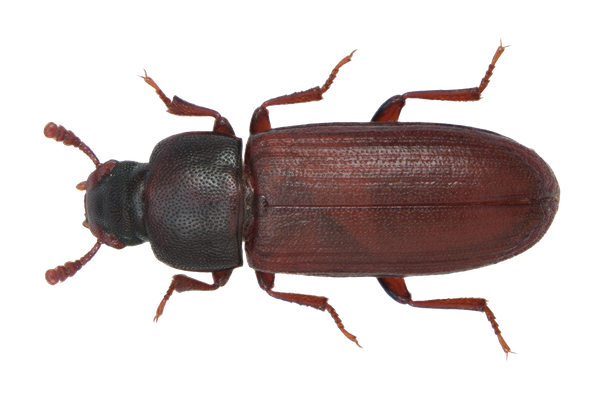| Description | The adult beetles (3–4 mm long), are flattened, reddish-brown with club-shaped segments on antennae ends. The larvae are elongate and light brown. Adults can fly. |
|---|---|
| Distribution | Cosmopolitan. Thought to have originated in India, but now found throughout all tropical, subtropical and warm temperate regions of the world. It is found in all grain-growing states of Australia. Less able to survive outdoors than the closely related species Tribolium confusum. |
| Pest status | Major, widespread, regular. Primarily an external feeding pest of milled products or damaged grain. It feeds on grain only after the seed coat has been broken (mechanically or by other insects) therefore a pest of secondary infestation. |
| Host range | Considered a secondary pest because it does not damage sound grain. Cream-coloured larvae feed externally on already damaged / processed grain and cereal dust. Mainly a pest of milled cereals and a common pest in stored cereal grain and processed grain products. Can also infest oilseeds, beans and nuts. |
| Damage | Both larvae and adults are general feeders and the damage caused by them is not readily identifiable. A heavy infestation in commodities discolours grain and emits a foul odour due to a secretion from the abdominal glands of the adult, resulting in an unpleasant smell and taste of infested material. |
| Life cycle | Adults live up to 2 years under optimal conditions. The adult female lays 2–10 eggs each day (up to 1000 eggs per female) during its life. Development of egg to adult takes up to 21 days under optimal conditions of 35ºC and 75% relative humidity. Length of the life cycle is 11 weeks at 22°C, and reproduction ceases below 20°C. |
| Means of protection |
Cultural control – The insect does not occur in standing crops. Therefore, good hygiene with storage and handling equipment should minimise infection. Prevention treatment by Methograin Delta IGR Grain Protectant is the primarily recommended product for prevention. To gain the widest possible range of protection Methograin Delta IGR Grain Protectant together with Methograin Fenitrothion 1000 can be applied. Chemical control – In case of infestation, fumigation in sealed storage. |
